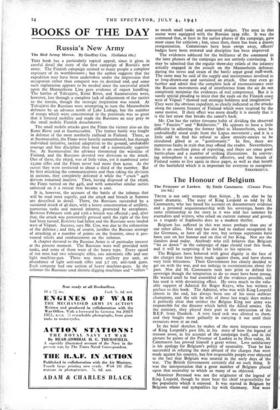BOOKS OF THE DAY
Russia's New Army
The Red Army Moves. By Geoffrey Cox. (Gollancz itSs.)
THIS book has a particularly topical appeal, since it gives in careful detail the story of the first campaign of Russia's new army. The Finnish campaign seemed to many people a complete exposure of its worthlessness ; but the author suggests that the expedition may have been undertaken under the impression that occupation rather than conquest was its destined end, and some such explanation appears to be needed since the successful attack upon the Mannerheim Line gave evidence of expert handling. The battles of Tolvajarvi, Kemi River, and Suomussalmi were, however, lost through a complete lack of adjustment of the tactics to the terrain, though the strategic inspiration was sound. At Tolvajarvi the Russians were attempting to turn the Mannerheim defences by an advance north of Lake Ladoga, but the number of troops which were concentrated in the peninsula was so great that it fettered mobility and made the Russians an easy prey to the small mobile Finnish detachments.
The small mobile attacks gave the Finns the victory also on the Kemi River and at Suomussalmi. The former battle was fought in defence of the most northerly railhead in Finland. There, as at Suomussalmi, the Finns were heavily outnumbered; but through individual initiative, tactical adaptation to the ground, unshakable courage and fine discipline they beat off a numerically superior foe. At Suomussalmi the advance threatened the waistline of Finland, and the Russians devoted two divisions to the attack. One of these, the 163rd, was of little value, yet it numbered some 12,000 rifles and the Finns never had more than 9,000. At the outset they were restricted to about a third of the number. But by first attacking the communications and then taking the division in sections, they completely defeated it while the " crack " 44th divison remained inactive. Then, having disposed of the 163rd, the Finns turned on the 44th, and with somewhat similar tactics enforced on it a retreat that became a rout.
It is, however, the account of the battle of the isthmus that will be read most eagerly, and the attack and breach at Summa are described in detail. There, the Russians succeeded by a sustained attack of 46 days, with a heavy concentration of artillery, numerous tanks and massed infantry, protected by aeroplanes. Between February loth and 13th a breach was effected ; and, after that, the attack was persistently pressed until the right of the line had been turned, Koivisto had fallen and the Russians were landed west of Viipuri. Success, says Mr. Cox, was due to the exhaustion of the defence ; and this, of course, justifies the Russian strategy of attacking at a number of points on the frontier, since it pre- vented reliefs and reinforcement on the isthmus.
A chapter devoted to the Russian Army is of particular interest at the present moment. The Russians were well provided with tanks, and some of them were of the heavy type. Every squad of ten men had two telescopic rifles, one automatic rifle and one light machine-gun. There was more artillery per unit, an abundance of light anti-tank rifles and 3.7 cm. anti-tank guns. Each company had one section of heavy machine-guns. In the isthmus the Russians used electric digging machines and " rollers "
to smash small tanks and armoured sledges. The men in that sector were equipped with the Russian 1939 rifle. It was the command that, at least in the earlier phases of the campaign, gave most cause for criticism ; but, since then, there has been a drastic reorganisation. Commissars have been swept away, officers' badges have been restored and discipline has been improved.
The evidences adduced for the brilliance of the command in the later phrases of the campaign are not entirely convincing. It may be admitted that the regular three-day reliefs of the infantry actually engaged in the assault on. the Mannerheim defences during the stress and strain of the battle argue good staff-work. The same may be said of the supply and maintenance involved in so long-drawn-out and sustained an attack. One may even go further and admit that the complete lack of reconnaissance over the Russian movements and of interference from the air do not completely minimise the evidences of real competence. But it is surely special pleading to insist that the raids on the Finnish coast west of Viipuri " showed real strategic boldness and imagination." They were the obvious expedient, as clearly indicated as the attacks along the eastern frontier of Finland which were inspired by the same motive. If their effect was more deadly it is merely that it is the last straw that breaks the camel's back.
Mr. Cox has the rather tiresome habit of dividing the observed into " Fascists " and " Bolshevists." He appears to have a little difficulty in adjusting the former label to Mannerheim, since he undoubtedly stood aside from the Lapua movement ; and it is a little odd to find his refusal to allow atrocity-stories to be circulated gibed at as " gentlemanly." In fine there are numerous faults in style that may offend the reader. Nevertheless, this is an excellent piece of reporting, and there are some good battle-plans and a number of striking illustrations. In convey- ing atmosphere it is exceptionally effective, and the breath of Finland seems to live again in these pages, as well as that breath of the battlefield which it is important for everyone to recognise.
STRATEGICUS.






























 Previous page
Previous page